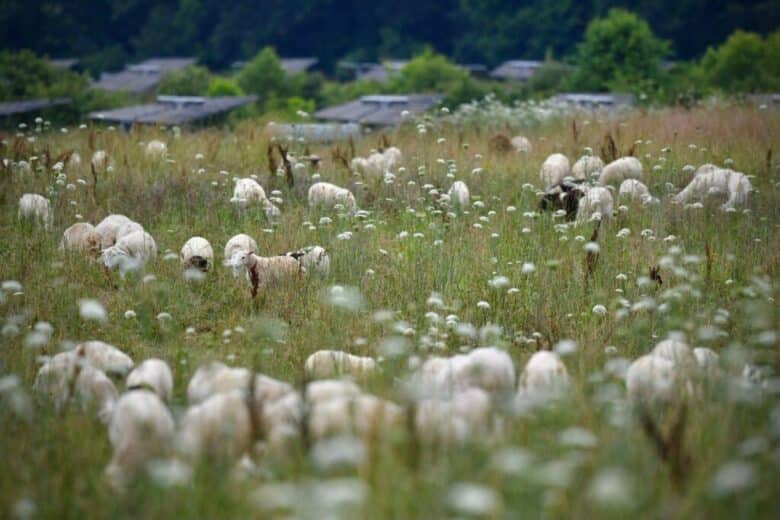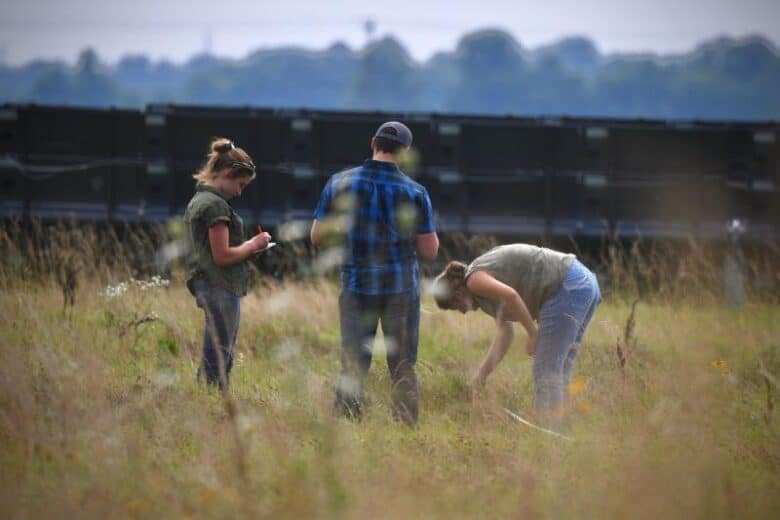How Can a Large Solar Farm Be a Good Neighbor?
Restoring Healthy Land Matters
Posted by Chris Ann Lunghino | May 31, 2022
Silicon Ranch is committed to being a good neighbor
From solar modules to substations, we carefully design, operate, and maintain all components of our solar projects, including the land we occupy, with nature and our neighbors in mind.
Healthy land matters
The solar industry has historically treated the land housing solar panels as a liability, a significant operations cost center. Rather than treating land as a liability, Silicon Ranch, through our Regenerative Energy® platform, manages the land housing our panels as a biological asset. We restore healthy soil, air, biodiversity, and water by implementing holistic strategies that mimic nature. We make solar do more.
Nature loves diversity, and so does Silicon Ranch
When it comes to land, this includes cultivating a healthy stand of multi-species grasses to prevent erosion, reduce fire fuel, and mitigate shade on the solar modules, three major operational concerns at solar projects.
Success in addressing erosion, fire fuel, and shade is interconnected and benefits our projects and our neighbors
Erosion
Erosion results from soil compaction and the impacts of water and wind on the soil. Compact soil prevents water from percolating into the ground — instead, rainwater rushes across the land and erodes soil. Erosion of soil can cause solar arrays to shift and become less efficient, and can require costly repairs or even become damaged beyond repair. It can also increase sedimentation in streams and rivers, reduce water quality, and lead to flooding. Erosion can affect not just our solar facility, but also downstream neighbors in the watershed.
Fire Fuel
Vegetation under solar modules can potentially serve as fuel for fire events if not properly maintained, especially in dry or semi-arid climates. Grassfires can start and spread quickly.
Shade
Shade from vegetation interferes with the operational efficiency of solar panels and can reduce the amount of clean electricity produced, to the detriment of both Silicon Ranch and the community we are serving. Even a small amount of shade can have a big negative impact when multiplied across an entire facility and over time.
Conventional Solutions to Solar Land Management Fall Short
Solar facilities deploy a variety of strategies to address these operational issues. Much of the conventional thinking on managing land, however, solves one challenge while causing problems in another area.
Mowing grasses very short, for example, can reduce fire fuel and potential shade, but leads to stressed and unhealthy vegetation with shallow roots that can cause erosion. Likewise spraying herbicide to prevent vegetation from shading the solar panels creates dead fire fuel, and fewer roots lead to erosion.
There is no easy, or even expensive, button to push to solve all three operational challenges. Ultimately, a holistic, nature-based approach is required to make maintenance and performance predictable.
Regenerative Energy’s® Approach to Solar Land Management Makes Solar Do More
The ideal operational focus for solving erosion, fire fuel, and shade is to cultivate a healthy stand of multi-species grasses
Through our Regenerative Energy® platform, we manage the land to promote long-term, deep-rooted vegetation, and plant growth cycles (rather than abating vegetation), soil health, biodiversity, and habitat creation. Intentionally choosing and cultivating multi-species grasses under our solar panels that are appropriate for the weather, climate, and shaded areas benefits our neighbors and our project.

Prevents Erosion
Over time, grass roots grow deep into the soil, securing them to the ground and aerating any compaction. This increases water percolation and creates a healthy environment for beneficial soil microbes and insects. Deep roots and aerated, healthier soil means cleaner water and less runoff.
Reduces Fire Fuel
Plants are fuel for fire. Green, living grass doesn’t burn as hot or spread flames as quickly as dry grass.
Synergistic Solar-Savannah Ecosystem
Everything is Connected
Mitigates Shade
Once a healthy stand of grasses is established, there can be ongoing work to mow or graze it. Despite the need for mowing or grazing, intentionally cultivating a diverse mix of grasses can still minimize the most labor-intensive work for shade mitigation. First, few grasses grow over six feet tall, the height of most solar arrays. Second, strong grasses out-compete woodier and invasive species that can grow above six feet (like dog fennel in the Southeast U.S. or Russian thistle in the West, which can grow over six feet and cause shade as well as fire issues). And even if grasses need to be cut down, any land management team would strongly prefer predictable and scheduled work to unplanned emergencies.

At Silicon Ranch, we act with our neighbors in mind
By seeding the right kinds of plants, and working within interconnected natural cycles, we are able to maintain healthy land underneath our solar modules to benefit our solar project and our neighbors. And we measure and third-party verify our ecological outcomes using the Savory Institute’s Ecological Outcome Verification assessment methodology, which measures the health of the land as a living system. In 2021, the Savory Institute certified the land housing seven Silicon Ranch Solar Ranches as ‘regenerative,’ the only solar land to receive this certification.